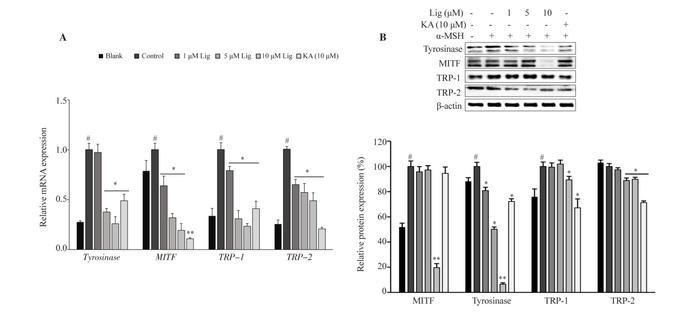
Ligustroside, a bioactive compound derived from Ligustrum japonicum, has garnered significant attention in recent years for its potential therapeutic properties, particularly in the area of skin health and pigmentation. Recent studies highlight its promising anti-melanogenic effects, showing significant promise as a natural agent for modulating melanin production in human skin cells. The intricacies involved in melanogenesis, the process of melanin synthesis, are influenced by various biological pathways, including the mitogen-activated protein kinase (MAPK) and protein kinase A (PKA)/cAMP response element-binding protein (CREB) signaling pathways.
In addressing the escalating concerns regarding hyperpigmentation and related skin disorders, ligustroside emerges as a potent inhibitor of melanin synthesis in B16F10 murine melanoma cells, which are widely used as a model system to study melanocyte biology and function. Experimental data indicate that treatment with ligustroside for a duration of 24 hours led to a notable decrease in melanin content and intracellular tyrosinase activity. The reduction in melanin synthesis was quantified, revealing a decrease of 37.11% for tyrosinase activity and 29.12% for melanin content compared to untreated controls. This stark revelation signifies ligustroside’s potential utility in dermatological applications aimed at reducing unwanted pigmentation.
The mode of action of ligustroside appears to be multifaceted, with investigations revealing that it exerts its effects by modulating the expression of key melanogenic markers—namely MITF (microphthalmia-associated transcription factor), tyrosinase, and tyrosinase-related proteins (TRPs), which are critical regulators in the melanogenesis pathway. Real-time quantitative PCR (RT-qPCR) and Western blot analyses confirmed that ligustroside downregulated these protein expressions at both mRNA and protein levels. Such modulation posits ligustroside as an attractive candidate for further development as a topical therapeutic agent for skin pigmentation disorders.
Researchers also investigated the phosphorylation of various MAPK pathways, including p38, ERK, and JNK, which play essential roles in the regulation of cell signaling cascades that influence melanogenesis. The phosphorylation status of these proteins was assessed through specific assays that confirm ligustroside’s inhibition of their activation. By suppressing this phosphorylation, ligustroside may effectively obstruct the signaling pathways that otherwise promote melanin production, thereby reinforcing its potential role as a therapeutic agent.
Immunofluorescence assays provided additional evidence of ligustroside’s effects, showing reduced levels of nuclear MITF, a crucial transcription factor required for melanocyte differentiation and function. The decreased immunofluorescence intensity of nuclear MITF in the treated cells supports the hypothesis that ligustroside may influence not only the biosynthetic pathway of melanin but also the intracellular localization of pivotal transcription factors involved in the regulation of pigmentation.
The significance of ligustroside extends beyond mere melanin inhibition; it primes discussions about alternative approaches to treating skin pigmentation disorders. The exploration of plant-derived compounds for medical applications has gained momentum, advocating for natural products over synthetic pharmaceutical alternatives seen to have deleterious side effects. Natural compounds like ligustroside reveal an untapped reservoir of bioactive agents that may reshape current standards in cosmetic and therapeutic dermatological practices.
Additionally, the increasing consumer interest in natural ingredients amplifies the need for scientific exploration into the safety and efficacy of such compounds. The research surrounding ligustroside contributes a compelling narrative that supports the use of plant-based treatments, catering to a market that favors less invasive and more holistic approaches to health care and beauty.
In summary, the compelling evidence presented in the recent findings unearthed by Xian-Rong Zhou and colleagues elucidates a pathway forward for ligustroside as a candidate for further research and development. The effectiveness in modulating melanogenesis via inhibition of MAPK and PKA/CREB signaling pathways presents an exciting avenue—promising innovative solutions for conditions such as hyperpigmentation and melasma, which affect countless individuals globally.
As the study aligns with ongoing trends toward the intersection of natural product research and dermatology, further investigations into the pharmacological potential of ligustroside may pave the way for new formulations designed for skin health. The fruitful endeavor of mining plant-based resources for innovative compounds may indeed lead to breakthroughs in how society addresses pigmentation disorders and ensures optimal skin health.
Likewise, the safety profile and effectiveness of continuous ligustroside application await thorough clinical trials, which can validate preliminary findings and extend its use in general dermatological practice. The journey from initial discovery to eventual application in therapeutic settings is complex yet rife with potential—drawing closer scrutiny towards this remarkable compound derived from a well-regarded botanical source.
Ultimately, advances in understanding the mechanisms underpinning ligustroside’s anti-melanogenic effects will be pivotal in substantiating its promises. With more comprehensive studies, ligustroside could transition from a research focus to a viable skincare solution, enabling enhanced esthetic outcomes and bolstering confidence for those seeking effective treatments for hyperpigmentation conditions.
This developmental trajectory encapsulates a confluence of scientific inquiry, consumer demand for natural alternatives, and the persistent pursuit of dermatological advancements. The implications of this research extend beyond academia, symbolizing a shift towards integrating holistic approaches into the fabric of modern dermatology.
Subject of Research: Cells
Article Title: Ligustroside derived from Ligustrum japonicum inhibits melanogenesis via blocking the MAPK and PKA/CREB signaling pathways
News Publication Date: 17-Jan-2025
Web References: https://journals.lww.com/aptb/pages/default.aspx
References: 10.4103/apjtb.apjtb_568_24
Image Credits: Credit: Xian-Rong Zhou, Fatih Karadeniz, Jung Hwan Oh, Youngwan Seo, Chang-Suk Kong
Keywords: Ligustroside, melanogenesis, skin health, MAPK pathway, natural compounds, dermatology, pigmentation disorders, Ligustrum japonicum, antioxidant effects, bioactive compounds.
Tags: B16F10 murine melanoma cellsbioactive compounds in skincaredermatological applicationshyperpigmentation managementLigustrosideLigustrum japonicumMAPK signaling pathwaymelanogenesis inhibitionnatural anti-melanogenic agentsPKA/CREB signaling pathwayskin pigmentation treatmenttyrosinase activity reduction





